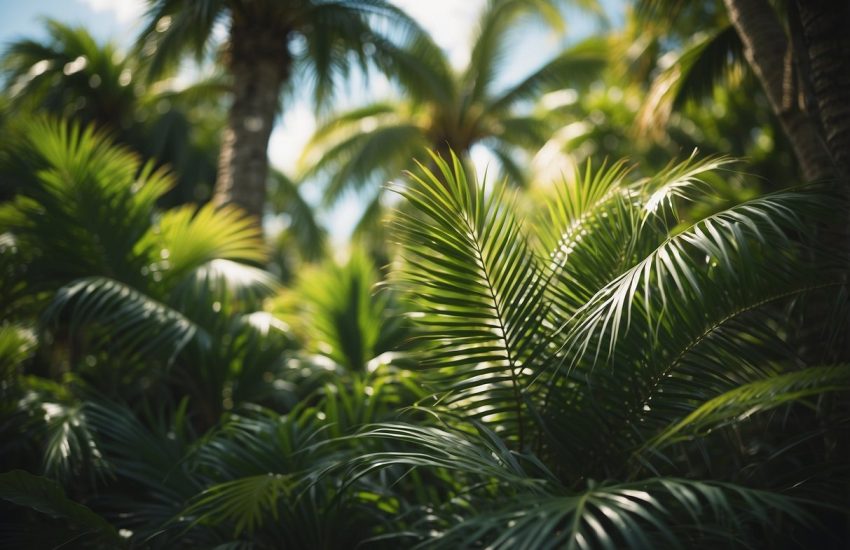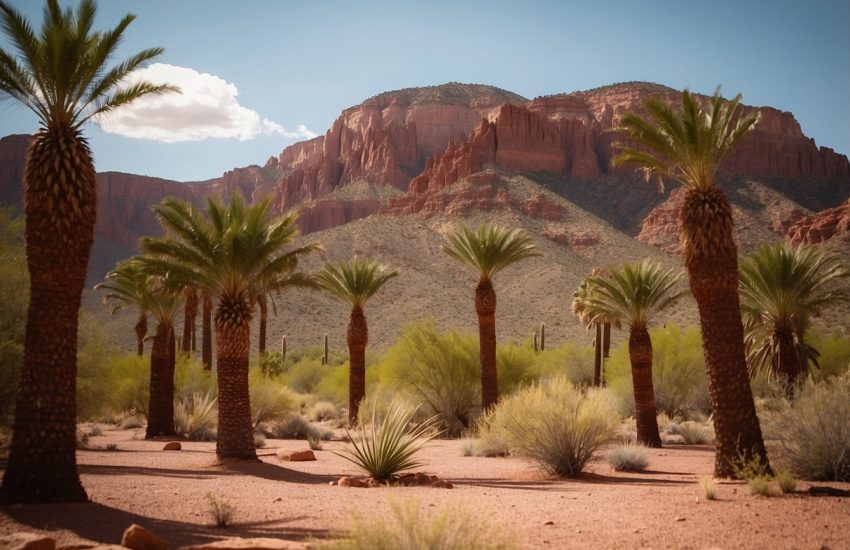7 Best Palm Trees To Grow In Tampa FL
Situated in the middle of Florida’s west coast, Tampa enjoys easy access to everything the state has to offer. Among those attractions are beautiful beaches, amusement parks, and tropical vegetation. The palm tree is regarded as one of the most iconic tropical plants, especially in Florida.
Florida’s natural scenery is dominated by palm trees, and we can use them to enhance our landscaping. As palm trees prefer full sun and high humidity, Tampa is an ideal place for growing them in your yard.
Tampa Palms is a neighborhood in New Tampa named after the palm trees that are such an iconic part of the city. And yes, you are correct if you guessed that palm trees are a prominent feature of the neighborhood.
It is possible to choose from more than 2,500 types of palm trees, and the vast majority can be grown in your Tampa garden. We will show you how to landscape with palm trees in Tampa once you have selected the right palm trees for your lawn.
There is a minimum temperature of 25-30 degrees in Tampa in winter, which is in USDA Hardiness Zone 9b. It is hot and humid in the summer (this is Florida, after all), but not quite warm enough for some palm species to thrive year-round.
It may sound silly to someone who has to endure Tampa’s hot summers, but you should look for varieties of palm trees that are cold-hardy.
Among the most popular cold-hardy species are the pindo palm, saw palmetto, and sago palm (which is not a palm but a cycad).
Some palm trees that aren’t as cold-hardy, such as those in Zones 10-11, may be able to survive in Tampa with the proper care in the winter.
In spite of this, these species are probably never going to reach the same level of size or vibrancy as their counterparts in the south.
There are many types of palm trees that you can choose from and here are a few tips on how to incorporate them into your landscape design.
European Fan Palm Tree
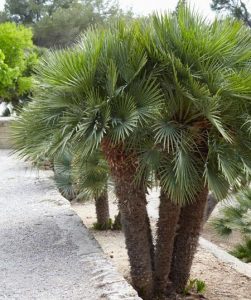
Almost anywhere in the world can be considered tropical. In this case, you will find the European Fan Palm Tree to be appropriate.
Having long, fan-shaped leaves that grow up to 24 inches long, it lends a tropical appeal that cannot be denied.
Beautiful in color, the European Fan Palm leaves produce a variety of greens, blues, grays, and yellows for your landscape.
Its unique shape makes it a show stopper. It is possible for the trunk of the European Fan Palm to reach a height of fifteen feet.
As this tree matures, it sprouts numerous trunks that encircle the main trunk. The trunk is brown in texture and resembles a pine cone with scales running along the length.
It is this layering effect that gives a sense of depth to any area of the building.
What’s more, it is low maintenance, so you don’t have to worry about it. Despite its length, the European Fan Palm is one of the easiest palms to take care of, since it is both durable and vibrant. This palm can withstand temperatures down to 20 degrees Fahrenheit and is drought-resistant.
Lady Baltimore Hibiscus
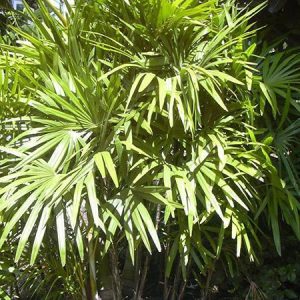
There is no doubt that the Lady Palm is one of the most popular plants to grow indoors because it easily adapts to areas with low light levels and even prefers to grow in shaded or shady areas.
Lady Palm does not require direct sunlight to thrive, and will fill any space with a unique tropical beauty.
Plus, the Lady Palm features multiple trunks that grow into lush, green, fan-shaped fronds with long, slender leaflets.
They create a vibrant, exotic ambience that replaces dull areas within the home or office with a vivid green hue.
The reason why Lady Palms are often found decorating entranceways, elevating bare corners, and framing entryways can be attributed to the fact that they are excellent accent pieces that are sure to welcome visitors with warmth.
What would be even better than that? I can tell you that they wouldn’t be more convenient to keep. Luckily, Lady Palms don’t require constant care.
They’re heat-resistant, drought-tolerant, and will grow just fine even if they’re left alone. As a matter of fact, they are actually doing your job for you, purifying the air and filtering out pollutants.
Sago Palm Tree
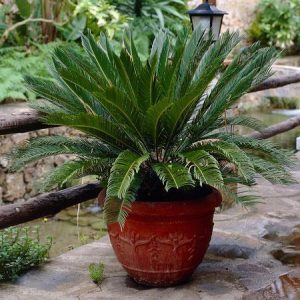
The Sago Palm Tree is characterized by feather-like foliage on a brown trunk with a textured surface.
Luxurious fronds of this cultivar are thick and glossy green, with the typical cascading effect of other palms.
In fact, it is considered a living fossil, as the species has not changed much over the last two million years.
Moreover, it appears so flawless, that it is often mistaken for a modern artificial plant.
Although it thrives in bright light, it can also tolerate moderate levels of illumination. As it is hardy down to 20 degrees, it is a good choice in any climate.
As it is hardy down to 20 degrees, it is a good choice in any climate. Due to its hardiness down to 20 degrees, it is an excellent choice in any climate. Low-maintenance and luxurious? Absolutely.
Either way, the Sago Palm provides an elegant and breezy island appearance that can be easily grown in any environment.
Although tough and elegant, the plant provides a tropical feel with minimal effort. Why not order yourself a few Sagos to experience what the hype is all about?
Mediterranean Fan Palm Tree
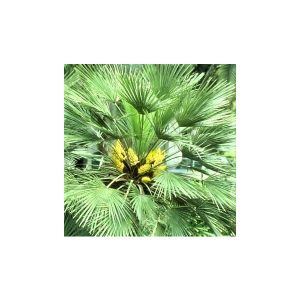
Mediterranean Fan Palms are among the most ornamental and versatile species of palms.
As an added bonus, it is one of the hardiest palm trees you’ll ever find, and even tolerates cold temperatures.
A specimen tree in your front yard or along your walkway will bring a sense of distinction to your home.
Fan palm can be used as container plants for your patio where some subtle backlighting will highlight their swaying fronds and the unique shadow patterns they cast.
There’s nothing like the calming, tropical ambiance this palm can bring into your home!
You can allow your Mediterranean Fan Palm to grow naturally in a shrub-like manner by leaving it unattended. However, many prefer to prune it into a tight bundle to emphasize the rough-hewn, tropical trunk that palms are known for.
Large, fan-like palmate foliage measures 36-inches or longer, creating an impressive “palm”. A symmetrical crown of 24-inch wide palm leaves atop the 4-foot stems that support them from the trunk forms a crown atop the palm. A wonderful contrast between their darker trunk and the blue-green coloration of their leaves.
Sylvester Palm
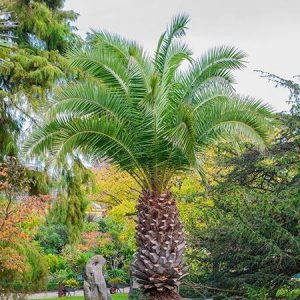
When you have always dreamed of bringing the tropics to your yard, then this is the palm for you.
There are a wide variety of climates and soils in which Sylvester palms can grow.
The plants are very drought-tolerant and require low maintenance. Please plant them and observe their growth.
There is no doubt that this Date Palm variety has the beautiful appearance that landscape designers are seeking.
As a result of their silvery blue-green leaves, they have a dazzling color that attracts people’s attention.
Diamond-shaped patterns on their trunks give it a textured appearance, making it seem as though it is covered in fur.
They have long weeping branches that spread into a perfectly symmetrical canopy as a result of their weeping nature. These weeping branches rest perfectly on top of a large trunk.
There are plenty of golf courses and resorts who are just dying to get their hands on them, and now you can have them right in your own backyard.
Ponytail Palm
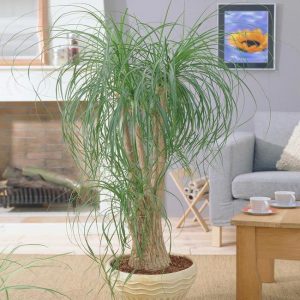
It has become increasingly popular to have Ponytail Palms as indoor plants. How come? To begin with, they have a tropical appearance that is unique.
The Ponytail Palm is also known as the Elephant Foot Palm due to its shape and texture similar to an elephant’s foot as well as its attractive gray bark that complements its lush green leaves.
During the summer months, thousands of tiny white blooms can be found on the stalk above the crown, creating an eye-catching display.
Since the Ponytail Palm is a container palm, it can be placed anywhere. As it only grows to around three feet tall indoors, it is ideal for placing on tables, countertops and in corners to add a touch of exoticism to any space.
Ponytail Palms are an outdoor plant that can be placed outside during the warmer months of the year to greet guests with their unique beauty.

